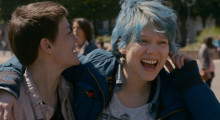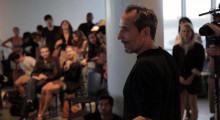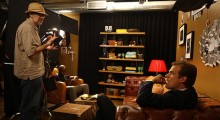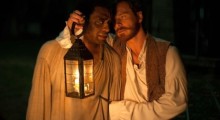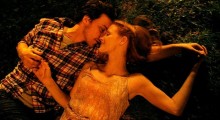6301 Results for “Open ”
-
Too Much of a Good Thing?

Digital cinema has afforded independent filmmakers many benefits, one of which is the ability to achieve something previously only the province of big-budget films: very high shooting ratios. However, the resulting mass of footage can overrun the typical understaffed, underfunded, low-budget edit room. “You’re shooting more footage, and usually with two cameras,” says Paul Frank, editor of the recent Maggie Carey comedy The To Do List. While he notes that there are many pros to this way of shooting — it benefits performance, it allows for more improvisation and, ultimately, more options in the edit room — he also notes […]
by Shaun Seneviratne on Oct 21, 2013 -
Hot to the Touch: Abdellatif Kechiche on Blue is the Warmest Color

When Adèle eats spaghetti, it’s a sensual affair. The camera studies every move of her mouth, every lick of her fingers and knife. Her eyes are saucers. Her full lips pout. Unlike the slurpy absurdity of noodle-eating in Juzo Itami’s Tampopo, in Blue is the Warmest Color, spaghetti is no laughing matter; it’s a matter of love. And, since it’s directed by Abdellatif Kechiche, it’s also a matter of class: Adèle’s comfort food indexes a working-class background that cannot be left behind. “That is a theme that one could say is central across all my films,” Kechiche said to me […]
by Livia Bloom Ingram on Oct 21, 2013 -
Matt Herron Talks Audition

Usually the term “a cast of hundreds” isn’t applied to a film with just two characters. But that’s exactly how to describe Matt Herron’s new feature Audition, an innovative film in which 100 actors — 50 men, 50 women — portray one couple over the course of a torrid romance. The concept is for this narrative story to be told through the documentary process of different actors interpreting the fictional roles (or, conversely, it could be seen as a documentary about acting that conveys a narrative storyline): the original 100 actors are winnowed down as the film progresses until the […]
by Randy Astle on Oct 21, 2013 -
13 Steps to Directing Famous Actors in a Microbudget Film

As I wind up my festival and theatrical run of my film Between Us, it’s gratifying to see the amazing reviews for our four-person ensemble cast, with critics using blurb-ready adjectives like “brilliant,” “razor-sharp” and “career-best” to describe the performances of Julia Stiles, Taye Diggs and Melissa George. David Harbour, in particular, just won the Best Actor prize at the Woods Hole Film Fest, and many reviews agree that he steals the movie in his breakthrough film performance. Naturally, all credit is due to the actors themselves. But a couple people nicely said that I couldn’t have screwed up the […]
by Dan Mirvish on Oct 21, 2013 -
Voices From the Street

A first feature by Omar Mullick and Bassam Tariq (chosen for Filmmaker’s 2012 25 New Faces of Independent Film), These Birds Walk is an observational documentary following the hopes of a young Karachi runaway named Omar. The boy, no more than 10-years-old, escapes his rural village and, as the film begins, is ready to run away from his city youth home. Omar is befriended by Asad, a young ambulance driver who works near the orphanage, which is maintained by one of Pakistan’s great philanthropists, elderly Abdul Sattar Edhi. Two questions resound through Omar’s days, through ups and downs: Where is […]
by Ray Pride on Oct 21, 2013 -
A More Perfect Union: Joe Brewster and Michele Stephenson on American Promise

In the increasingly tony Fort Greene neighborhood just east of downtown Brooklyn, filmmakers Michele Stephenson and Joe Brewster raised a son named Idris. Very early on in his youth, just as their son was about to become one of the few young black males to enroll in The Dalton School, a vaunted Upper East Side prep school that either trains young masters of the universe in the ways of maintaining their hegemony or educates a diverse set of the city’s best students in a humane and liberal environment (all depends on your outlook), the couple decided to make a documentary. […]
by Brandon Harris on Oct 18, 2013 -
iOS 7 at the One-Month Mark: 18 Picks and Pans

Apple’s “polarizing” mobile operating system iOS 7, an update which stripped away the skeuomorphism (i.e., the fake leather and other real-world metaphors found in apps like Calendar and Game Center) of previous versions in favor of a “flat” design style, was unveiled by the company on June 10 at its WWDC keynote and pushed to users on September 18. And for the most of this year, the Apple media universe — the parade of blogs and podcasts that have made a mini-industry of commenting upon the Cupertino company — have spoken of little else. But now that the OS is […]
by Scott Macaulay on Oct 18, 2013 -
Introducing Screen X, Cinema in 270 Degrees

The Busan International Film Festival saw the launch of Screen X, a cinema technology that promises to offer audiences an immersive cinematic experience without the need to wear glasses. The South Korean company behind the technology, CJ CGV Screen X, owns the CGV cinema chain and currently operates one American location in Los Angeles. To showcase the technology, CJ CGV Screen X commissioned The Good, The Bad, The Weird director Kim Jee-Woon to make The X. Ostensibly a spy thriller, it’s really just an excuse to show off the technology that augments the action on screen, by projecting images onto […]
by Kaleem Aftab on Oct 17, 2013 -
Screenwriter John Ridley Talks 12 Years a Slave

12 Years a Slave — the title of Steve McQueen’s latest, taken from its source material, the Solomon Northup memoir — is one of the most direct and descriptive of recent cinema history. But consider further the subtitle of Northup’s 1853 book: “Narrative of Solomon Northup, a citizen of New-York, kidnapped in Washington city in 1841, and rescued in 1853, from a cotton plantation near the Red River in Louisiana.” It’s one of the film’s extraordinary achievements that, as it lands in theaters nationwide with the headwinds of an Oscar frontrunner, it tells, on its most basic level, that story. […]
by Scott Macaulay on Oct 16, 2013 -
On Watching Half of The Disappearance of Eleanor Rigby

In the Fall issue of Filmmaker that went to the printer last week is my coverage of the 2013 Toronto International Film Festival. But there’s one film — or, rather, half a film — I didn’t write about. I’ll explain, but that involves a detour into a discussion of ’90s experimental theater. The Sarajevo-based Open Stage Obala’s Tattoo Theatre is a lovely work that follows a couple from courtship to old age, tracing their loves, infidelities and reunions with evocative, unexpected imagery. (Old age, for example, is represented by the actors standing face to audience and covering themselves with flour.) […]
by Scott Macaulay on Oct 15, 2013

